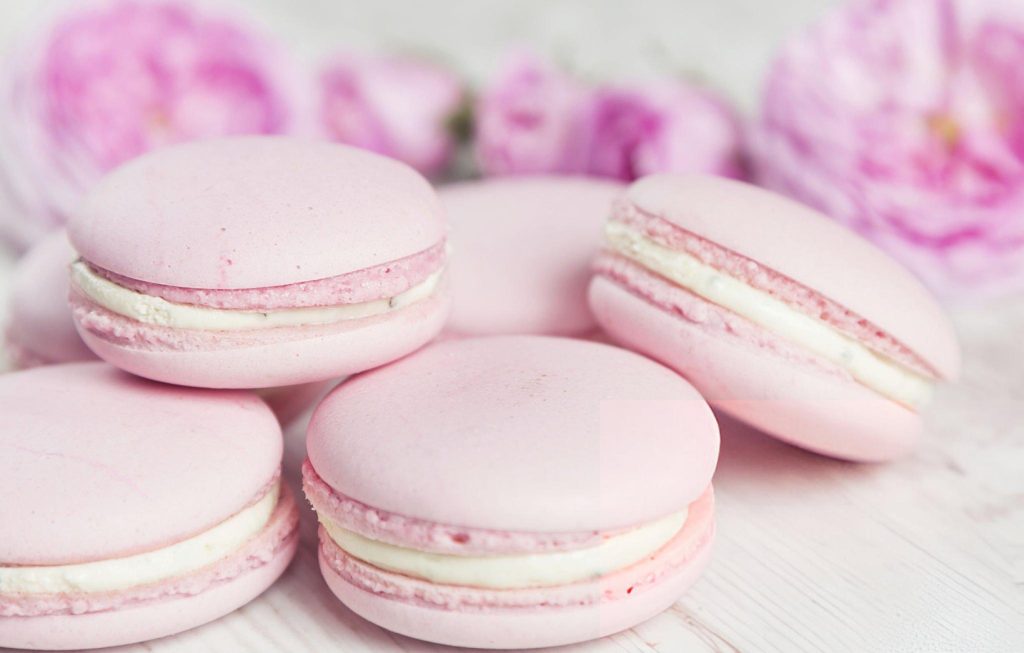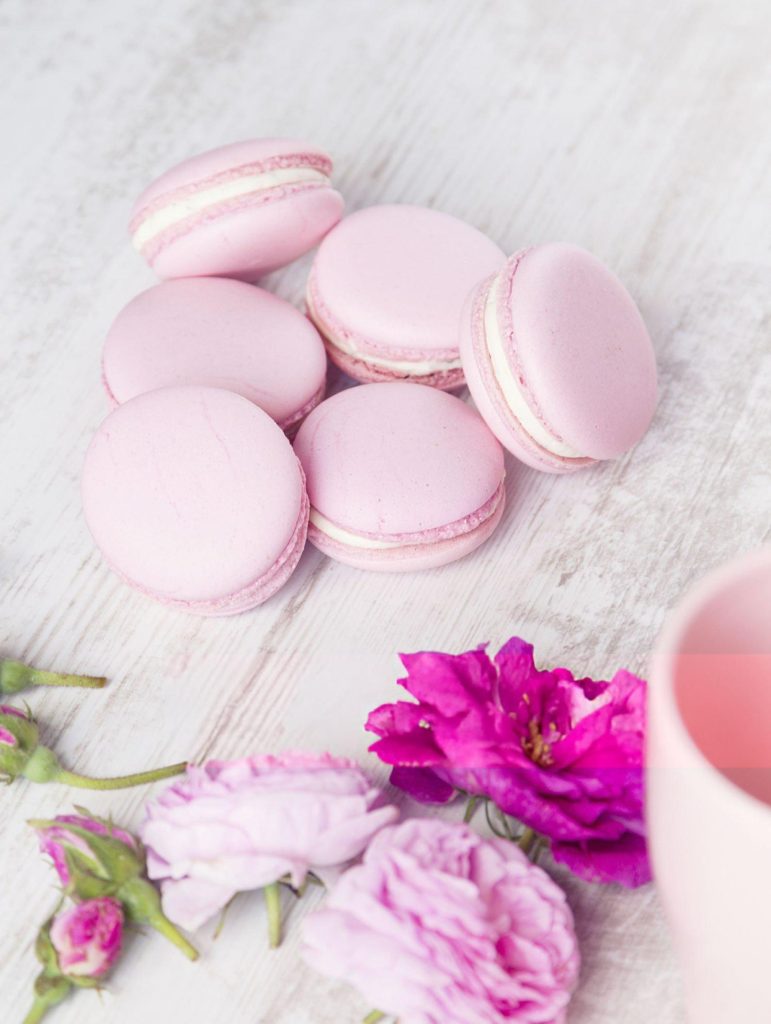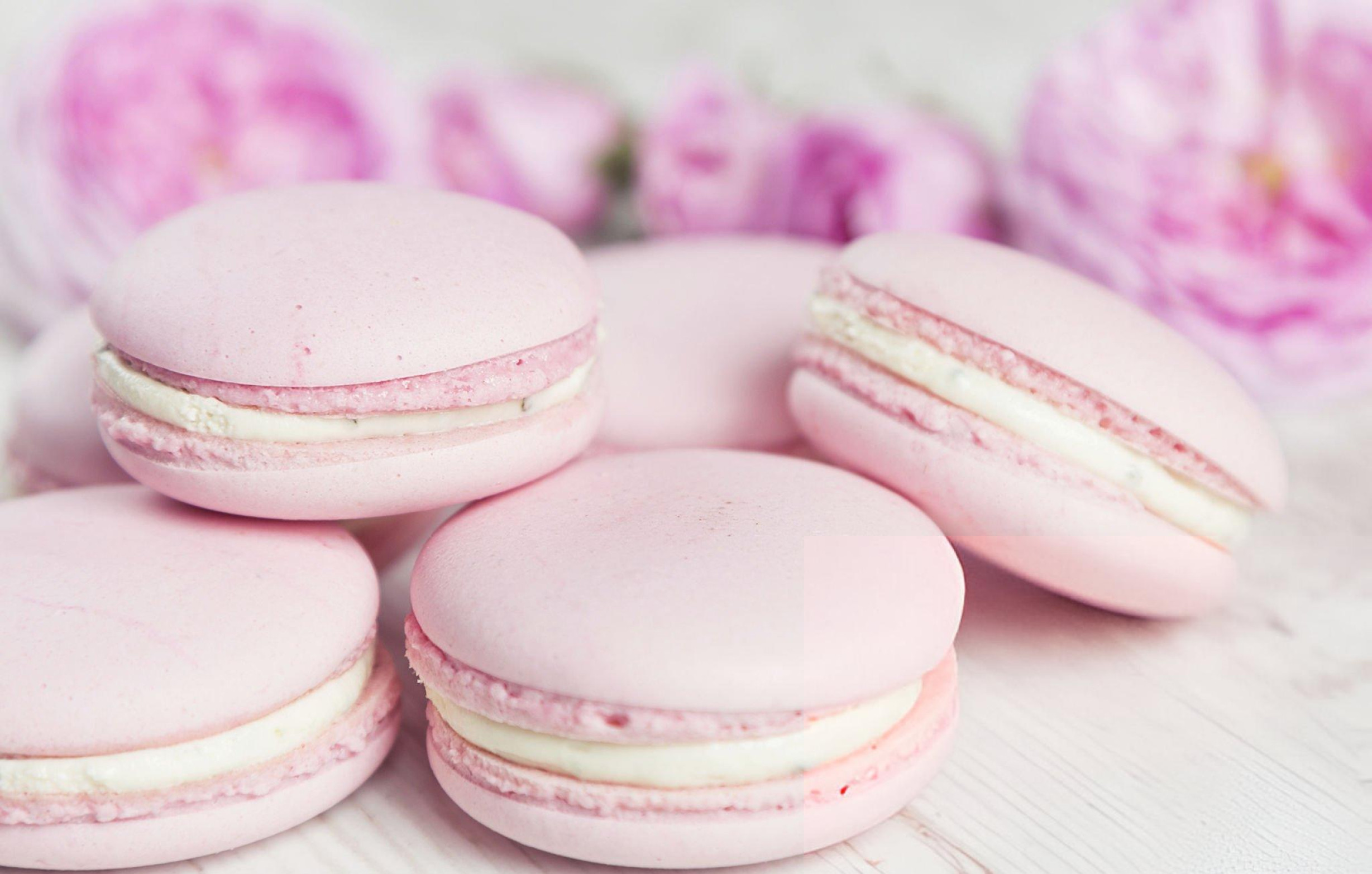French Macarons Recipe
French macarons are the epitome of elegance in the baking world. With their crisp, airy shells and luscious fillings, they captivate both the eyes and the taste buds. These delicate confections have earned a global following for their charming appearance and irresistible texture. Whether you’re a seasoned baker or a curious beginner, mastering macarons is a rewarding journey, offering endless possibilities for flavor combinations and creative presentations.

Ingredients Breakdown
The magic of macarons begins with a carefully curated list of ingredients. Almond flour serves as the base, providing the distinct nutty flavor and fine texture that characterizes the shells. The balance between almond flour and confectioners’ sugar is crucial for achieving smooth, shiny tops and the coveted “feet” at the base of the macarons.
Egg whites play a pivotal role in the structure of the macarons. Beaten into stiff, glossy peaks, they introduce airiness into the batter while acting as the glue that holds the almond mixture together. Superfine sugar, also known as caster sugar, is incorporated in stages, allowing the egg whites to stabilize and achieve the perfect meringue. Cream of tartar helps in stabilizing the egg whites, while a hint of extract—vanilla, almond, or coconut—infuses the shells with subtle aromatic undertones.
Lastly, gel food coloring is optional but often used to make macarons as visually delightful as they are delicious. The filling is where creativity truly shines, with a myriad of options ranging from classic buttercream to rich ganache or tart fruit curds.
Step-by-Step Instructions
Preparation of egg whites starts the day before. Allowing the egg whites to age in the refrigerator for 24 hours helps reduce their moisture content, which in turn leads to a more stable meringue. On the day of baking, they must be brought back to room temperature to ensure they whip up properly.
Once ready, the egg whites are combined with cream of tartar and beaten to soft peaks. At this stage, superfine sugar is added gradually, ensuring the mixture remains smooth and glossy. This step is key, as achieving stiff peaks creates the backbone of the macaron’s structure, preventing them from collapsing during baking.
The dry ingredients, almond flour, and confectioners’ sugar are sifted together, ensuring a light and lump-free consistency. The beaten egg whites are gently folded into the almond mixture, a process known as macaronage. The goal is to achieve a batter that is thick yet flows like lava. A simple figure-eight test helps determine if the consistency is just right—if the batter flows in a continuous stream and takes about 10 seconds to sink back into itself, it’s ready.
Piping the macarons onto a baking sheet requires precision. Holding the piping bag at a 90-degree angle and spacing the rounds evenly ensures uniform macarons. After piping, tapping the trays on the counter releases any air bubbles trapped within the batter, which could otherwise cause the macarons to crack.
Resting the macarons before baking is essential. This step allows the tops to dry out, forming a thin skin that leads to the formation of feet during baking. When touched gently, the tops should no longer feel tacky, indicating they are ready for the oven.
Baking the macarons is where the transformation occurs. A preheated oven at 325°F (163°C) provides the right amount of heat to set the tops while the feet form underneath. To test if they are done, gently touch the top of a macaron—if it feels firm and doesn’t wobble, they’re ready to come out of the oven.

Recipe Tips
Mastering the Macaronage:
The folding process is delicate, and patience is key. Fold too little, and your macarons will crack; fold too much, and they’ll spread too thin. Aim for a batter that flows gently but doesn’t run.
Perfecting the Shells:
Smooth, shiny tops come from properly sifting your dry ingredients and folding them in carefully. Don’t rush through this step, and make sure your piping technique is consistent.
Troubleshooting Common Issues:
Hollow shells are a common problem caused by over-whipped egg whites or underbaked shells. Cracking can result from under-resting the piped macarons, while a lack of feet indicates improper resting or baking temperatures.
What to Serve With This Recipe
Macarons are more than just a dessert—they’re a luxurious treat that pairs beautifully with a variety of beverages. A freshly brewed espresso or a fragrant cup of tea brings out the subtle flavors of the shells and filling. For a more indulgent experience, serve macarons with a chilled glass of champagne or sparkling wine, enhancing the celebratory feel of these elegant treats.
To complement the delicate sweetness of macarons, consider serving them alongside other light, airy desserts. Fruit tarts or sorbets provide a refreshing contrast, while rich dark chocolate truffles add an indulgent touch.
Flavor Variations and Filling Suggestions
Classic flavors such as vanilla, chocolate, and pistachio are timeless favorites, but the beauty of macarons lies in their versatility. Incorporating different extracts, like almond or coconut, can transform a basic macaron into something more exotic.
For the filling, buttercream is a classic choice, but ganache, jams, or curds can take your macarons to the next level. A silky dark chocolate ganache is perfect for the chocolate lover, while a tangy lemon curd offers a refreshing contrast to the sweet shells. Seasonal flavors, like pumpkin spice in autumn or fresh raspberry in summer, keep the possibilities endless.
Frequently Asked Questions
Why Do My Macarons Crack?:
Cracks are often caused by overmixing the batter or baking at too high of a temperature. Ensuring the macarons rest long enough to form a skin is also crucial in preventing cracks.
How Can I Store Macarons?:
To keep macarons fresh, store them in an airtight container in the refrigerator for up to five days. Before serving, bring them to room temperature for the best texture and flavor.
Can I Freeze Macarons?:
Yes, macarons can be frozen for up to a month. Store them in an airtight container, layering parchment paper between the macarons to prevent sticking. When ready to enjoy, allow them to thaw in the refrigerator and then bring to room temperature.
Macarons are a visual delight, and presenting them can be just as fun as baking them. For special occasions, arrange them on a tiered tray or in a decorative box for a gift-worthy display. Incorporating different colors and flavors can create a vibrant macaron tower, perfect for celebrations like weddings or birthdays.
Personalizing your macarons with decorative elements adds an extra touch of elegance. A sprinkle of edible glitter or a drizzle of contrasting chocolate can elevate their appearance, making them the star of any dessert table.

Ingredients
125g almond flour
125g confectioners’ sugar
100g egg whites (approximately 3–4 large egg whites)
80g superfine sugar (caster sugar)
1/4 teaspoon (1g) cream of tartar
1/2 teaspoon vanilla, almond, or coconut extract (optional)
1–2 drops gel food coloring (optional)
Your choice of macaron filling (see notes for ideas)
Instructions
Start by prepping your workspace. Use lemon juice or vinegar to thoroughly wipe down a large glass or metal mixing bowl. Pour the egg whites into the bowl, cover, and place in the refrigerator for 24 hours. When ready to use, bring the egg whites to room temperature.
Prepare three large baking sheets by lining them with silicone baking mats or parchment paper and set them aside.
To the egg whites, add the cream of tartar and extract, if using. With a stand mixer or handheld mixer set to medium speed, whisk the mixture until soft peaks begin to form. The initial foam will tighten into bubbles, and soon the beaters will leave faint lines in the mixture. At this point, start adding the superfine sugar, one-third at a time, beating for 5 seconds after each addition. Once all the sugar has been incorporated, increase to medium-high speed and whisk until the mixture forms stiff, glossy peaks. When done correctly, the peaks will be smooth and firm without drooping. You can test this by inverting the bowl; the mixture should stay in place. Gently fold in gel food coloring, if desired.
Sift the almond flour and confectioners’ sugar into a clean mixing bowl, pushing any larger pieces through the sieve with a spoon. Discard as little of the dry mixture as possible to ensure you have the correct quantities.
Slowly fold the whipped egg whites into the dry almond flour mixture in three parts, making sure each addition is fully combined before adding more. As you fold, keep an eye on the batter’s consistency—it should gradually become similar to honey. Perform the figure 8 test by allowing the batter to fall from your spatula in a figure 8 shape; it should take no more than 10 seconds to settle back into the batter. If it takes longer, continue gently folding until you achieve the right texture.
Transfer the macaron batter to a piping bag fitted with a round tip (Wilton 12, Wilton 1A, or Ateco 806 will work well). Holding the piping bag directly over the prepared baking sheets at a 90-degree angle, pipe out rounds about 1.5 to 2 inches in diameter, spacing them 1–2 inches apart. Tap the baking sheets on the counter to release any air bubbles and use a toothpick to pop any visible ones.
Let the piped macarons rest at room temperature for 30–60 minutes until the tops are dry to the touch and no longer tacky. This will help them form their characteristic ruffled “feet” when baked. Avoid leaving them out for too long, as they may begin to deflate.
While the macarons are resting, preheat your oven to 325°F (163°C).
Bake the macarons for about 13 minutes, checking their doneness by gently touching the tops. If they wobble, bake for an additional 1–2 minutes. Once firm and no longer moving, remove them from the oven and let them cool on the baking sheets for 15 minutes before transferring to a wire rack. If the macarons stick to the parchment paper, allow them to cool for a bit longer.
Once completely cooled, they are ready to be filled. Use a piping bag or a knife to add your chosen filling, then sandwich the macarons together. You can enjoy them immediately, but some bakers recommend refrigerating the assembled macarons for 12–24 hours to allow the flavors to develop. Bring them back to room temperature before serving.
Store any leftovers in the refrigerator for up to five days.

French Macarons Recipe
Ingredients
- 125 g almond flour
- 125 g confectioners’ sugar
- 100 g egg whites approximately 3–4 large egg whites
- 80 g superfine sugar caster sugar
- 1/4 teaspoon 1g cream of tartar
- 1/2 teaspoon vanilla almond, or coconut extract (optional)
- 1 –2 drops gel food coloring optional
- Your choice of macaron filling see notes for ideas
Instructions
- Start by prepping your workspace. Use lemon juice or vinegar to thoroughly wipe down a large glass or metal mixing bowl. Pour the egg whites into the bowl, cover, and place in the refrigerator for 24 hours. When ready to use, bring the egg whites to room temperature.
- Prepare three large baking sheets by lining them with silicone baking mats or parchment paper and set them aside.
- To the egg whites, add the cream of tartar and extract, if using. With a stand mixer or handheld mixer set to medium speed, whisk the mixture until soft peaks begin to form. The initial foam will tighten into bubbles, and soon the beaters will leave faint lines in the mixture. At this point, start adding the superfine sugar, one-third at a time, beating for 5 seconds after each addition. Once all the sugar has been incorporated, increase to medium-high speed and whisk until the mixture forms stiff, glossy peaks. When done correctly, the peaks will be smooth and firm without drooping. You can test this by inverting the bowl; the mixture should stay in place. Gently fold in gel food coloring, if desired.
- Sift the almond flour and confectioners’ sugar into a clean mixing bowl, pushing any larger pieces through the sieve with a spoon. Discard as little of the dry mixture as possible to ensure you have the correct quantities.
- Slowly fold the whipped egg whites into the dry almond flour mixture in three parts, making sure each addition is fully combined before adding more. As you fold, keep an eye on the batter’s consistency—it should gradually become similar to honey. Perform the figure 8 test by allowing the batter to fall from your spatula in a figure 8 shape; it should take no more than 10 seconds to settle back into the batter. If it takes longer, continue gently folding until you achieve the right texture.
- Transfer the macaron batter to a piping bag fitted with a round tip (Wilton 12, Wilton 1A, or Ateco 806 will work well). Holding the piping bag directly over the prepared baking sheets at a 90-degree angle, pipe out rounds about 1.5 to 2 inches in diameter, spacing them 1–2 inches apart. Tap the baking sheets on the counter to release any air bubbles and use a toothpick to pop any visible ones.
- Let the piped macarons rest at room temperature for 30–60 minutes until the tops are dry to the touch and no longer tacky. This will help them form their characteristic ruffled “feet” when baked. Avoid leaving them out for too long, as they may begin to deflate.
- While the macarons are resting, preheat your oven to 325°F (163°C).
- Bake the macarons for about 13 minutes, checking their doneness by gently touching the tops. If they wobble, bake for an additional 1–2 minutes. Once firm and no longer moving, remove them from the oven and let them cool on the baking sheets for 15 minutes before transferring to a wire rack. If the macarons stick to the parchment paper, allow them to cool for a bit longer.
- Once completely cooled, they are ready to be filled. Use a piping bag or a knife to add your chosen filling, then sandwich the macarons together. You can enjoy them immediately, but some bakers recommend refrigerating the assembled macarons for 12–24 hours to allow the flavors to develop. Bring them back to room temperature before serving.
- Store any leftovers in the refrigerator for up to five days.
Notes
- Freezing: Freeze cooled macaron shells or assembled macarons for up to 1 month. Thaw at room temperature before filling/serving.
- Tools Needed: Electric mixer, glass/metal mixing bowls, egg separator, food scale, fine mesh sieve, piping bag, medium-round piping tip (Wilton 12, Wilton 1A, Ateco 806), baking sheets, silicone baking mat or parchment paper, cooling rack.
- Ingredient Tips: No substitutions recommended. Weigh ingredients for best results. Approximate measurements: superfine sugar – 1/3 cup, almond flour and confectioners’ sugar – 1 cup + 1 tsp each.
- Egg Whites: Use fresh egg whites, not carton liquid egg whites.
- Flavoring: Macarons have a natural almond flavor. Add 1/2 tsp extract (e.g., almond, vanilla) if desired.
- Superfine Sugar: Make by pulsing 80g granulated sugar in a food processor 10-15 times until fine.
- Food Coloring: Gel food coloring is best; avoid liquid. Use 1-2 drops. Powder coloring should be fine, but untested.
- Almond Flour: Use fine almond flour, not almond meal. Almond flour is blanched, skinless, and finer.
- Filling Ideas: Vanilla buttercream, chocolate buttercream, Nutella frosting, cream cheese frosting, ganache, salted caramel, etc.

